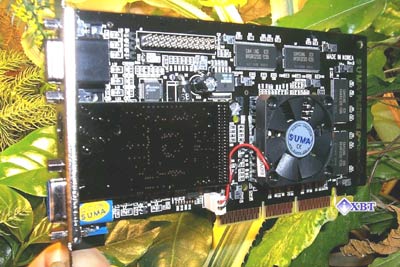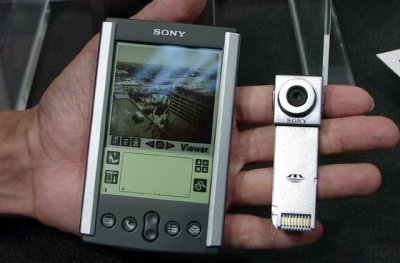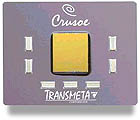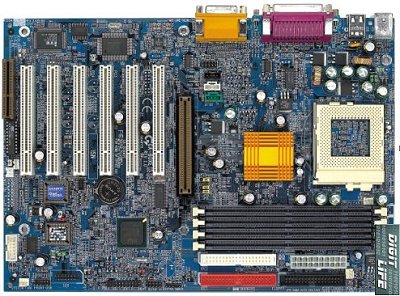Bij Digit-Life hebben ze een roundup online gekwakt over een vijftal GeForce2 (MX) videokaarten van Suma. Deze *kuch* erg bekende fabrikant uit Zuid-Korea produceert onder andere een leuke serie GeForce2 kaarten. De Suma GeForce2 familie bestaat uit 2 GeForce2 kaarten, en 3 GeForce2 MX kaarten waar onder 1 twin-view exemplaar. Bijzonder qua features is geen één van de Suma kaarten te noemen, ze zijn allemaal gebaseerd op het reference design afgezien van de koeler. Maar wat wel leuk is, is dat Suma ook een paar kaarten heeft met Special Edition in de naam. Dit houd in dat alle componenten geplakt zitten op een mooi zwart stukje PCB. Je hebt ongetwijfeld gelijk dat de videokaart hier absoluut niet harder van gaat lopen, maar het oog wilt ook wat ![]() :
:
Today we managed to put our hands on cards from SUMA company from South Korea. SUMA stands for SuperMicro System. The company was founded in 1998 and at once it became an exclusive partner of AOpen. Later it concluded contracts with 3dfx (at that time it produced only Voodoo2 and Voodoo Banshee chipsets) and with NVIDIA (Riva TNT). In the end, SUMA received a widespread acceptance both in Korea and in other South-East Asia countries. And it's known even in the USA. Unfortunately, Europe doesn't know it.
[...] SUMA products easily compete against the cards of such manufacturers as ASUS or Creative. SUMA cards have a unique design, a rich complete set and high quality. The price for SUMA production is low, however. For example, 32 MB card on GeForce2 GTS costs appr. $230, and GeForce2 MX based card costs $115.
![]() Suma Platinum GeForce2 GTS SE 64MB:
Suma Platinum GeForce2 GTS SE 64MB:
 |
![]() Suma Platinum GeForce2 MX SE TwinView 32MB:
Suma Platinum GeForce2 MX SE TwinView 32MB:
 |







 Motherboards manufacturers are rapidly improving the way to inform you of potential problems. In the past users could hear the beep code. Later on there were diagnostic LED's. Now manufacturers are starting to use voices to inform users. FIC demonstrated Audio Alert II at last year's Comdex, which uses voices coming through the external speakers to let users know that memory, CPU, or video has not been detected after power on. With our evaluation AZ11E, FIC actually included the optional daughter board module, which is required for the Audio Alert II to function. There is also software where users can record their own voice or greetings and save them to the flash memory.
Motherboards manufacturers are rapidly improving the way to inform you of potential problems. In the past users could hear the beep code. Later on there were diagnostic LED's. Now manufacturers are starting to use voices to inform users. FIC demonstrated Audio Alert II at last year's Comdex, which uses voices coming through the external speakers to let users know that memory, CPU, or video has not been detected after power on. With our evaluation AZ11E, FIC actually included the optional daughter board module, which is required for the Audio Alert II to function. There is also software where users can record their own voice or greetings and save them to the flash memory.

:strip_exif()/i/1124121765.gif?f=fpa)

 Currently, Transmeta's 5600 PC chip runs only at 600 MHz, leaving some analysts to wonder if supply issues had surfaced. Ditzel denied that his company was having trouble securing processed wafers. "IBM is a wonderful partner," he said, referring to Transmeta's current foundry source.
Currently, Transmeta's 5600 PC chip runs only at 600 MHz, leaving some analysts to wonder if supply issues had surfaced. Ditzel denied that his company was having trouble securing processed wafers. "IBM is a wonderful partner," he said, referring to Transmeta's current foundry source.




 UPC heeft het nettoverlies over het derde kwartaal van zijn boekjaar zien oplopen tot 640 miljoen euro (f 1,4 miljard). Vorig jaar boekte de kabelaar in dezelfde periode nog een negatief resultaat van 170 miljoen euro. De omzet verdubbelde naar 258 miljoen euro (f 568 miljoen).
UPC heeft het nettoverlies over het derde kwartaal van zijn boekjaar zien oplopen tot 640 miljoen euro (f 1,4 miljard). Vorig jaar boekte de kabelaar in dezelfde periode nog een negatief resultaat van 170 miljoen euro. De omzet verdubbelde naar 258 miljoen euro (f 568 miljoen).
 652)
652) )
) 1)
1)


 The company says it will now sell its chips to third-party manufacturers, who will create the boards that go in computers. Because 3dfx is in its quiet period (its latest earnings are due next week), officials declined to say how much of a write off would result from the closing of the Mexican plant.
The company says it will now sell its chips to third-party manufacturers, who will create the boards that go in computers. Because 3dfx is in its quiet period (its latest earnings are due next week), officials declined to say how much of a write off would result from the closing of the Mexican plant.
 Intel's 0.13-micron Pentium III, codenamed Tualatin, will make its first appearance beginning in Q3 of 2001 at 1.26 GHz on the "B-Step" i815e platform. Furthermore, the desktop Tualatin variant will ship with a 256 KB L2 cache, just as the current Pentium III Coppermines do now. This is in contrast to previous reports indicating a 512 KB ondie cache for the 0.13-micron Pentium III. We can only speculate as to the motivations behind this change, but with the appearance of the 1.3 GHz Pentium 4 and therefore more aggressive pricing, it is safe to assume that Intel is more interested in moving the Pentium 4 into mainstream market segments than prolonging the life of the P6. Considering Tualatin's small die size and low production costs, as well as its established and inexpensive platform, it could represent a considerable threat to the Pentium 4's acceptance in the mainstream market. By maintaining the current 256 KB L2 cache size and restricting Tualatin to a 133 MHz FSB using standard SDRAM, Intel is able to effectively limit the competitive pressure Tualatin can exert against the Pentium 4 platform.
Intel's 0.13-micron Pentium III, codenamed Tualatin, will make its first appearance beginning in Q3 of 2001 at 1.26 GHz on the "B-Step" i815e platform. Furthermore, the desktop Tualatin variant will ship with a 256 KB L2 cache, just as the current Pentium III Coppermines do now. This is in contrast to previous reports indicating a 512 KB ondie cache for the 0.13-micron Pentium III. We can only speculate as to the motivations behind this change, but with the appearance of the 1.3 GHz Pentium 4 and therefore more aggressive pricing, it is safe to assume that Intel is more interested in moving the Pentium 4 into mainstream market segments than prolonging the life of the P6. Considering Tualatin's small die size and low production costs, as well as its established and inexpensive platform, it could represent a considerable threat to the Pentium 4's acceptance in the mainstream market. By maintaining the current 256 KB L2 cache size and restricting Tualatin to a 133 MHz FSB using standard SDRAM, Intel is able to effectively limit the competitive pressure Tualatin can exert against the Pentium 4 platform.